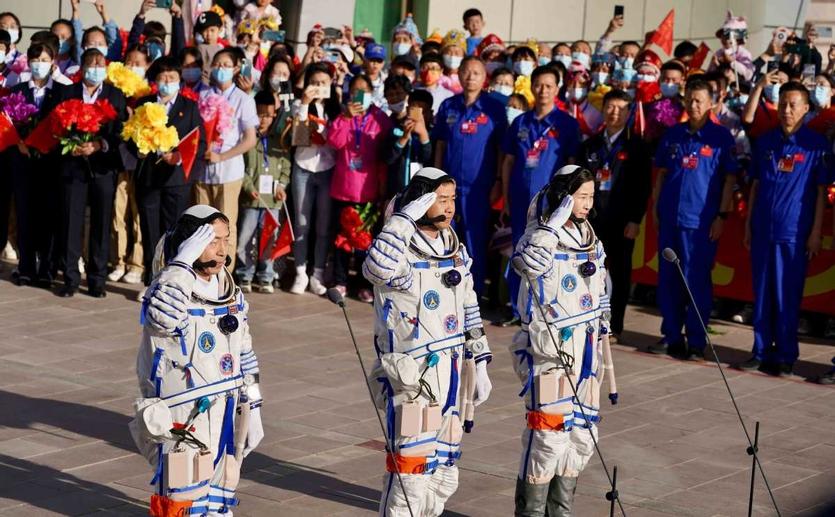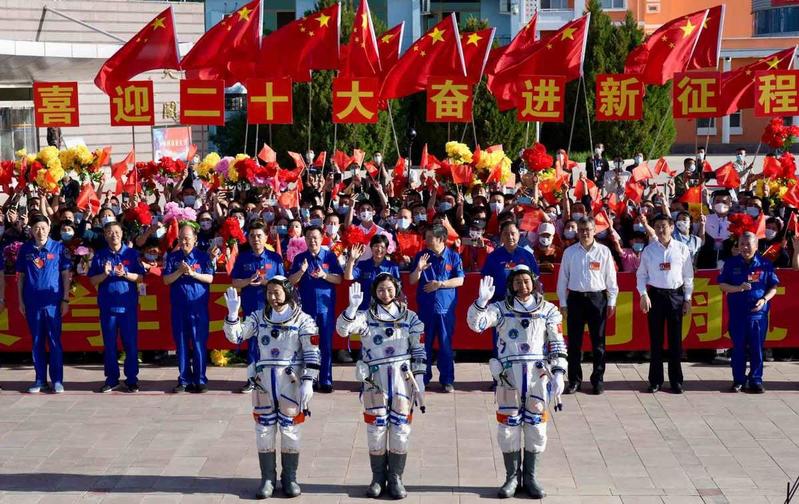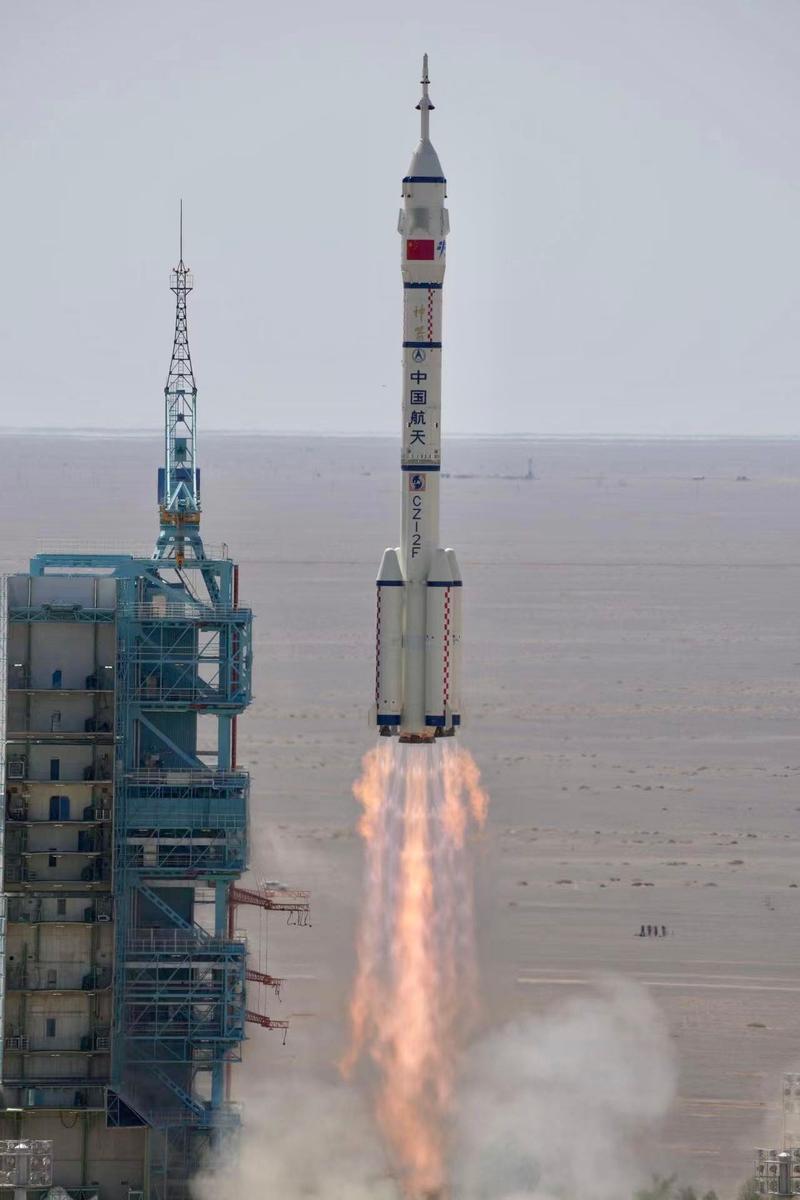 A Long March 2F rocket carrying the Shenzhou XIV spacecraft blasts off from the Jiuquan Satellite Launch Center in Northwest China on June 5, 2022. (WANG JIANGBO / PROVIDED TO CHINADAILY.COM.CN)
A Long March 2F rocket carrying the Shenzhou XIV spacecraft blasts off from the Jiuquan Satellite Launch Center in Northwest China on June 5, 2022. (WANG JIANGBO / PROVIDED TO CHINADAILY.COM.CN)
The Shenzhou XIV mission — China's ninth manned spaceflight — launched Sunday morning from the Jiuquan Satellite Launch Center in the northwestern Gobi Desert.
A Long March 2F rocket carrying the spacecraft blasted off at 10:44 am from a service tower inside the oasis-like launch center.
A Long March 2F rocket carrying the spacecraft blasted off at 10:44 am from a service tower inside the oasis-like launch center
The three crew members – mission commander Senior Colonel Chen Dong, Senior Colonel Liu Yang and Senior Colonel Cai Xuzhe – are being sent to the Tiangong space station. They are scheduled to stay there for half a year to complete the assembly of the colossal station.
This is the second time Chen and Liu have ventured into space.
When the crew's mission finishes around the end of this year, the Tiangong station will be fully operational.
ALSO READ: China to launch Shenzhou XIV crewed spaceship Sunday
The flight of Chen and his teammates is also expected to mark the beginning of a decade where, barring no accidents, there will be Chinese people in outer space every day.
Shenzhou XIV is the sixth spacecraft to visit Tiangong station and the third crewed ship to transport astronauts to the orbiting outpost.
As of the spacecraft's arrival on Sunday afternoon, the Tiangong station consists of three parts — the Tianhe core module and the Tianzhou 3 and the Tianzhou 4 cargo ships.
 A see-off ceremony for three Chinese astronauts of the Shenzhou XIV manned space mission is held at the Jiuquan Satellite Launch Center in Northwest China on June 5, 2022. (SU DONG / FOR CHINADAILY.COM.CN)
A see-off ceremony for three Chinese astronauts of the Shenzhou XIV manned space mission is held at the Jiuquan Satellite Launch Center in Northwest China on June 5, 2022. (SU DONG / FOR CHINADAILY.COM.CN)
The Shenzhou XIV crew, all from the second generation of the country's astronauts, will work with ground controllers to connect the Wentian and Mengtian space labs with the Tianhe module and then use a robotic arm to move the labs to their permanent position, Lin Xiqiang, deputy head of the China Manned Space Agency, said at a news conference inside the Jiuquan center on Saturday.
Wentian, the station's first lab component, will be lifted in July by a Long March 5B rocket from the Wenchang Space Launch Center in Hainan province, while the second lab Mengtian will be launched by the same rocket model from Wenchang in October. After they are connected with Tiangong, the station will form a T-shaped structure.
Other tasks for the astronauts include installing and configuring equipment, conducting scientific experiments and technological demonstration and maintaining routine operations of the Tiangong station.
During their stay, the astronauts will fulfill two to three spacewalks and give science lectures to students, he said.
ALSO READ: China's space station to host 6 astronauts by end of 2022
In the second half of their mission period, the Tianzhou 5 cargo craft and the Shenzhou XV crew are scheduled to arrive at the massive station. The Shenzhou XIV and XV crews will meet inside the Tiangong and work together for a short time before Chen's crew flies back to Earth in December, the official said.
Before them, the Shenzhou XII and XIII crews, both with three members, lived inside Tiangong, which is travelling in a low-Earth orbit about 400 kilometers up. The Shenzhou XIII crew returned in mid-April.
 A see-off ceremony for three Chinese astronauts of the Shenzhou XIV manned space mission is held at the Jiuquan Satellite Launch Center in Northwest China on June 5, 2022. (SU DONG / FOR CHINADAILY.COM.CN)
A see-off ceremony for three Chinese astronauts of the Shenzhou XIV manned space mission is held at the Jiuquan Satellite Launch Center in Northwest China on June 5, 2022. (SU DONG / FOR CHINADAILY.COM.CN)
In early May, the Tianzhou 4 cargo spacecraft was launched by a Long March 7 rocket from the Wenchang Space Launch Center in Hainan province, transporting nearly 6 metric tons of propellants and materials to the station.
Tiangong is expected to operate for up to 15 years and will serve as a scientific platform, space officials have said, noting it will also be open to foreign astronauts.
In April 1971, the former Soviet Union became the first in the world to operate a space station with the deployment of its Salyut 1 station in low-Earth orbit. Since then, 10 space stations have been launched, most built by the Soviet Union.
Before Tiangong, the only operational station was the International Space Station, a joint effort by several national space agencies including the United States' NASA and Russia's Roscosmos. China was excluded from the project mainly due to US objections.
 A Long March 2F rocket carrying the Shenzhou XIV spacecraft blasts off from the Jiuquan Satellite Launch Center in Northwest China on June 5, 2022. (SU DONG / PROVIDED TO CHINADAILY.COM.CN)
A Long March 2F rocket carrying the Shenzhou XIV spacecraft blasts off from the Jiuquan Satellite Launch Center in Northwest China on June 5, 2022. (SU DONG / PROVIDED TO CHINADAILY.COM.CN)


